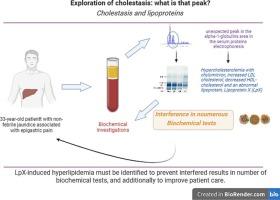胆汁淤积症的生化探索:解读、陷阱和干扰。
IF 2.5
3区 医学
Q2 MEDICAL LABORATORY TECHNOLOGY
引用次数: 0
摘要
我们描述了一例 33 岁患者的病例,他因非发热性黄疸伴上腹疼痛到急诊科就诊。他患有急性非重度酒精性肝炎和胆汁淤积症。生化检查结果显示,α-1-球蛋白部分显著升高,血清蛋白电泳中α-1-球蛋白区域出现意外峰值,严重高胆固醇血症,但无黄疽或胆固醇瘤。检查发现了一种异常脂蛋白--脂蛋白 X(LpX),它可能是导致高胆固醇血症的原因,但也会干扰生化检测,如直接低密度脂蛋白胆固醇、白蛋白和血清电解质检测。LpX 是一种异常脂蛋白,可出现在肝功能异常的患者中,尤其是在胆汁淤积相关疾病中,因为在这些疾病中,血浆脂蛋白的代谢会发生改变。胆汁淤积会阻碍胆汁酸的正常形成,从而形成 LpX,它富含磷脂和未酯化胆固醇,但酯化胆固醇、甘油三酯和蛋白质含量较低。LpX 的积累可导致严重的高胆固醇血症,但这种情况并不常见,有关这种疾病的病理生理学和发病率的数据也很少。由于缺乏测量 LpX 的可用方法,对疑似 Lpx 患者进行实验室检查具有挑战性。总之,必须识别由 LpX 引起的高脂血症,以防止一些生化检验结果受到干扰,并改善对患者的护理。本文章由计算机程序翻译,如有差异,请以英文原文为准。

Biochemical exploration of cholestasis: interpretation, traps and interferences
We described the case of a 33-year-old patient who presented to the emergency department with non-febrile jaundice associated with epigastric pain. He suffered from acute non-severe alcoholic hepatitis and cholestasis. Biochemical investigations highlighted a huge elevation of the alpha-1-globulins fraction with an unexpected peak in the alpha-1-globulins area in serum protein electrophoresis, a severe hypercholesterolemia without xanthelasmas nor cholesterolomas. Investigations revealed an abnormal lipoprotein, Lipoprotein X (LpX) that can be responsible for the hypercholesterolemia, but also interferes with biochemical tests like direct low-density lipoprotein cholesterol, albumin, and serum electrolytes assays. LpX is an abnormal lipoprotein, which can be present in patients with liver dysfunction, notably in cholestasis-related conditions where the metabolism of plasma lipoproteins is altered. Cholestasis prevents the normal formation of bile acids, leading to the formation of LpX, which is rich in phospholipids and unesterified cholesterol, but poor in esterified cholesterol, triglycerides and proteins. The accumulation of LpX can lead to severe hypercholesterolemia, but this remains uncommon and data regarding the pathophysiology and incidence of this disease is scarce. The laboratory investigation of patients with suspected Lpx can be challenging, due to the lack of available methods for measurement of LpX. In conclusion, LpX-induced hyperlipidemia must be identified to prevent interference in results for a number of biochemical tests, and additionally to improve patient care.
求助全文
通过发布文献求助,成功后即可免费获取论文全文。
去求助
来源期刊

Clinical biochemistry
医学-医学实验技术
CiteScore
5.10
自引率
0.00%
发文量
151
审稿时长
25 days
期刊介绍:
Clinical Biochemistry publishes articles relating to clinical chemistry, molecular biology and genetics, therapeutic drug monitoring and toxicology, laboratory immunology and laboratory medicine in general, with the focus on analytical and clinical investigation of laboratory tests in humans used for diagnosis, prognosis, treatment and therapy, and monitoring of disease.
 求助内容:
求助内容: 应助结果提醒方式:
应助结果提醒方式:


